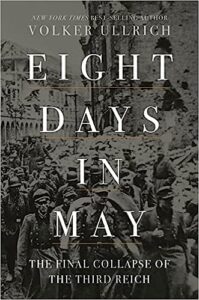YUGOSLAVS RECLAIM BELGRADE FROM NAZIS
Belgrade, Yugoslavia • October 22, 1944
By late March 1941 Yugoslavia, a multiethnic nation of 15.5 million people in Central and Southeast Europe, was surrounded on all sides by Axis-aligned nations with the exception of Greece to its south. Romania and Hungary had joined Yugoslavia’s neighbor to the west, Italy, in the Tripartite Pact in late November 1940 and Bulgaria was a signatory in early March 1941. Adolf Hitler, the leader of the pact, tried inveigling Yugoslavia’s leaders to join the others, offering Belgrade generous terms such as guaranteeing Yugoslavia’s territorial integrity. Kowtowing seemed the better of 2 virtues (the other being standing firm against Hitler’s diplomatic machinations), so Yugoslav Prince Regent Paul sent emissaries to Vienna, Austria (annexed to Germany in 1938), to enroll in the pact on March 25, 1941. A British-sponsored, anti-Axis coup d’état by the Yugoslav military forced Paul into exile, ending his regency.
On April 6, 1941, Yugoslavia was assaulted on 3 sides by Axis armed forces, primarily German but also Italian, Hungarian, and Bulgarian. The invasion lasted little more than 10 days, ending with the unconditional surrender of the Yugoslav Army on April 17 and the flight of 17‑year-old King Peter II and other members of his government from the country.
The victors occupied and dismembered the Yugoslav nation. They instituted such severe burdens on the local populace that the Partisans, a Communist-led pan-ethnic resistance movement under Marshal Josip Broz Tito, grew to enjoy moral and material support inside and, to a lesser extent, outside the country after President Franklin D. Roosevelt, British Prime Minister Winston Churchill, and Soviet dictator Joseph Stalin decided in late 1943 to support Tito’s forces with supplies, equipment, and commando operations. (A rival resistance group, the monarchist and Republican Chetniks, was comprised mainly of Serbians with limited popularity outside their homeland partly because of allegations they engaged in ethnic cleansing within borders they considered historically Serbia.)
In late 1944 Tito’s forces numbered 650,000 men and women organized in 4 field armies and 52 divisions and had a 3,000-strong navy and an air force. In a joint operation with the Partisans, the Red Army entered Belgrade on October 20, 1944, evacuated the day before by the Germans, followed on this date, October 22, 1944, by the entry of Tito’s Partisans into the Yugoslav capital. Partisan units engaged retreating Germans in the last battle in Europe on May 14–15, 1945, a week after Germany’s unconditional surrender to the Allies in Reims, France, and Berlin.
Yugoslavia was one of only 2 European countries largely liberated by its own forces during World War II. The other country was the Soviet Union. Both nations suffered proportionately high casualties because Nazi Germany and its collaborators in the occupied territories and puppet states (e.g., the Independent State of Croatia in Yugoslavia) had an official genocidal agenda with respect to the inhabitants living there, especially toward Jews. Yugoslavia suffered just over 1 million civilian and military dead during the Axis occupation. Some 300,000 civilians were killed by the Croatian terrorist organization, Ustaša, in German-style concentration camps.
Marshal Josip Broz Tito and Yugoslavia During World War II
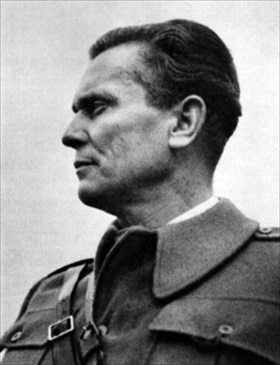 | 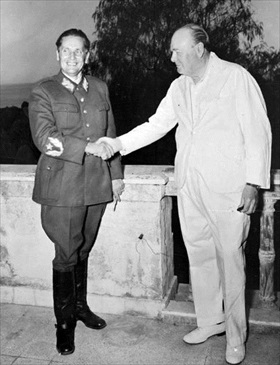 |
Left: Yugoslavia’s Partisans, or the National Liberation Army, was Europe’s most effective anti-Nazi resistance movement. Its commander was Marshal Josip Broz Tito, shown here in 1942. Tito mostly played down his Communist Party ties in favor of a Popular Front approach that appealed to all Yugoslavs. Tito’s rival was Draža Mihailović and his royalist Chetnik resistance movement. To the Chetniks, Tito’s pan-ethnic policies seemed anti-Serbian, whereas the Chetniks’ royalism was anathema to the Communists. From October 1941 relations between the 2 main resistance groups degenerated into full-scale conflict.
![]()
Right: For most of the war in Yugoslavia the only source of Partisan weapons was the enemy—Germany, Italy, other Axis nations, and puppet Yugoslav militia. It was not until 1944 when British supplies began to arrive in significant quantities that a credible offensive force took to the field. This picture shows Tito and British Prime Minister Winston Churchill in Naples, Italy, in 1944, the year the Allies switched their support from Mihailović and his Chetniks to Tito’s Communist Partisans. Churchill later regretted the switch.
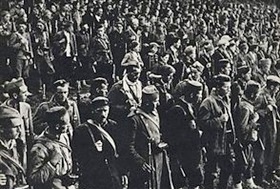 | 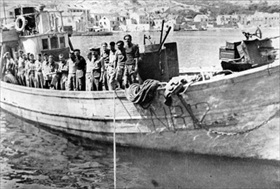 |
Left: Soldiers of the 4th Montenegrin Proletarian Brigade. Tito’s Partisan organization was a multiethnic resistance force consisting of Serbs (44%), Croats (30%), Bosnian Muslims (2.5%), Slovenes (10%), Montenegrins (5%), Macedonians (2.5%), and Jews. By April 1945, when most of Yugoslavia had been liberated, Partisan forces numbered 800,000.
![]()
Right: Yugoslavian Partisans operated along the Croatian coast of Hitler’s puppet state, the so-called Independent State of Croatia, run by the Ustaša, a fascist and terrorist organization. Tito’s Partisan navy raided German supply lines using a number of light boats, often ex-trawlers or fishing boats as shown in this photograph. The Partisan navy had a number of successes, partially assisted by a little-known British naval unit consisting of a half-dozen armed boats, the Special Boat Service led by a 23‑year-old Dane, Major Anders Lassen. Yugoslavian Partisans forced a schooner of 400 tons full of supplies to surrender after shouting, “Don’t shoot or we will torpedo you,” even though the boat had no torpedoes.
Photo Montage of Yugoslav Partisans
![]()

 History buffs, there is good news! The Daily Chronicles of World War II is now available as an ebook for $4.99 on Amazon.com. Containing a year’s worth of dated entries from this website, the ebook brings the story of this tumultuous era to life in a compelling, authoritative, and succinct manner. Featuring inventive navigation aids, the ebook enables readers to instantly move forward or backward by month and date to different dated entries. Simple and elegant! Click
History buffs, there is good news! The Daily Chronicles of World War II is now available as an ebook for $4.99 on Amazon.com. Containing a year’s worth of dated entries from this website, the ebook brings the story of this tumultuous era to life in a compelling, authoritative, and succinct manner. Featuring inventive navigation aids, the ebook enables readers to instantly move forward or backward by month and date to different dated entries. Simple and elegant! Click 











